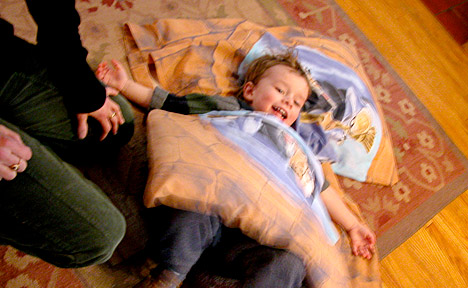
People games are games requiring a partner. Modify the play environment so that your child will need you in order to enjoy the experience. The main goal is to encourage communication. Your child will learn things such as: paying attention, starting or ending a game and taking a turn. Just like with people toys, these games are very structured and predictable. Words and actions are repeated many times, making it easy for your child to take a turn in the play.
Remember to make your play time R.O.C.K. by:
- Repeating what you say and do.
- Offering Opportunities for your child to take his turn.
- Cueing your child to take his turn.
- And finally Keeping it fun
The specifics of how you provide opportunities to take a turn and what you can expect from your child will depend on your child’s stage of communication. If your child usually plays on his own, you will want to entice him to play and enjoy being with you. If he is just starting to ask to enter play, then the goal is to get more practice at this and to extend the game a little longer. Later, you can provide opportunities to “use his words” and to take more elaborate turns in the conversation. The trick is to take it one step at a time, give lots of practice and most of all to have fun.
The following are just a few ideas of people games you can play with your child. Once you get the hang of them, you’ll be able to create your own. Don’t forget to add music and singing to your games.
Jumping and Up and Down Games
There are lots of different versions of this game. Jumping on the spot involves taking your child’s hands or lifting under the arms and counting “1… 2…3…go” (or blast off ). On “go”, lift your child into the air and bring him down again.
If your child is small, you can vary this game by tossing him in the air or spinning him. You can also try letting him hold your hands and climb up your legs to flip over.
Horsey Rides
Get down on your hands and knees. Let your child climb onto your back for a ride. For extra fun, you can neigh and sway side to side. When you stop, he must ask you to re-start the game. He can do this through body gestures, sounds and words, depending on his language level.
Swinging Games
Swinging games tend to be quite hard on your back so be careful. If there are 2 people, you can each grab a hand and lift him into the air as you say “1…2…3… swing.”
An alternative is to have one person hold his hands and the other hold his feet while singing “Swinging. Swinging. (moving side to side) Now we go up (swing him up quickly). Now we go down (bump his bottom gently on the ground).”
Race Car
Lie on your back with your knees up. Then your child can sit down with his back against your knees. Your hands become the steering wheel. Then take off! You bump and rock your torso over the road, lean right and left for racing around curves. Don’t forget to make the sound effects! You both crash at the end of the race.
Bouncing
An oversized, exercise ball can be lots of fun for you and your child. Your child can sit on the ball or lie on it with your support. Bounce him up and down while saying “bounce” or “up and down”. Start off with a slow and steady pace, pause, then quicken the pace. As a variation, try rocking back and forth or side to side. Make up your own song to accompany this.
The Sandwich Game
Try squeezing games such as making a “sandwich” by placing your child between pillows, or making a “hot dog” by rolling the child in a blanket. A more elaborate version of this is to let your child build a sandwich out of you. First lay down a pillow; that is the bread. Then you lie on top of it to become the meat. Then let your toddler pile up pillows, blankets and toys on top of you for the pickles, lettuce, tomato, cheese, etc., and lastly a pillow matching the bottom one for the other slice of bread. Now it’s lunch time!!! Don’t forget to cry out “No, no, don’t eat me”. He’ll want a turn being the sandwich next, and be sure to add some tickles.
Peek-a-boo or Hiding Games
Put a blanket or cloth over your child’s face. Say “Where’s ____(name)?”, then pull the cloth away and find him. If your child likes tickles or kisses, give him a quick one when you find him and say “There’s ____ (name).” You can take turns hiding as well. Other variations are hiding behind hands, pillows etc.
Chasing Games
Running and chasing games are favourites with most children. Start by running after your child. Saying “I’m going to get you.” When you catch him give him a big tickle, hug, or a kiss and say “Got you”. After he understands the games, encourage him to take a turn chasing you. Start by taking a few steps away and then looking back at him. Laugh and wait for him to catch you. Then give him another turn being chased.

nice